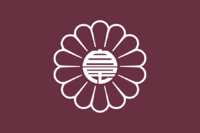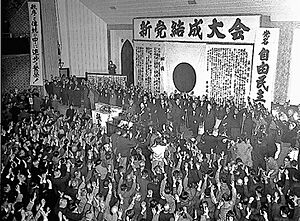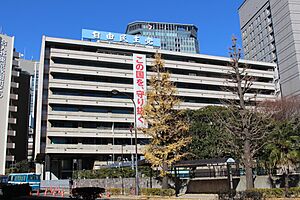Liberal Democratic Party (Japan) facts for kids
Quick facts for kids
Liberal Democratic Party
自由民主党 Jiyū-Minshutō
|
|
|---|---|
 |
|
| Abbreviation | LDP Lib Dems Jimintō |
| President | Shigeru Ishiba |
| Vice President | Yoshihide Suga |
| Secretary-General | Hiroshi Moriyama |
| Founders |
|
| Founded | 15 November 1955 |
| Merger of |
|
| Headquarters | 11–23, Nagatachō 1-chome, Chiyoda, Tokyo 100-8910, Japan |
| Newspaper | Jiyu Minshu |
| Student wing | LDP Students Division |
| Youth wing | LDP Youth |
| Membership | |
| Ideology |
|
| Political position | Right-wing |
| National affiliation | LDP–Komeito coalition |
| Colours |
|
| Slogan | 日本を守る。成長を力に。 Nihon o mamoru. Seichō o chikara ni. ('Protect Japan. Turn growth into strength.') |
| Anthem | "We" |
| Councillors |
101 / 248
|
| Representatives |
195 / 465
|
| Prefectures |
1,301 / 2,644
|
| Municipalities |
2,137 / 29,135
|
| Election symbol | |
| Party flag | |
 |
|
| Website | |
|
|
|
^ A: The Liberal Democratic Party is a big-tent conservative party (see factions table below). The LDP has also been described as centre-right, but the LDP has far-right and ultraconservative factions, including members belonging to the ultranationalist Nippon Kaigi. |
|
The Liberal Democratic Party (自由民主党, Jiyū-Minshutō), often called LDP or Jimintō, is a major political party in Japan. It is known for its conservatism and focus on Japanese nationalism. Since it was founded in 1955, the LDP has been in power for most of the time. This long period is sometimes called the 1955 System. There were only two times it was not in charge: from 1993 to 1996, and again from 2009 to 2012.
The LDP was created in 1955 when two conservative parties, the Liberal Party and the Japan Democratic Party, joined together. Its first leader was Ichirō Hatoyama. The LDP has always supported Japan's alliance with the United States. It also helped create strong connections between Japanese businesses and the government. This played a big part in Japan's amazing economic growth from the 1960s to the early 1970s.
The party faced some challenges and lost power briefly in 1993 and 2009. However, it regained control in 2012 under Shinzo Abe. As of August 2025, the LDP holds 191 seats in the House of Representatives and 101 seats in the House of Councillors. The party has been working with the Komeito party in a coalition government since 1999. The main opposing party in Japan's politics is currently the Constitutional Democratic Party (CDP).
The LDP is often seen as a "big tent" party. This means it includes many different types of conservative ideas, from moderate to more right-wing nationalism. The party does not have one single, strict political idea. However, it generally supports increasing defense spending and keeping strong ties with the United States. In recent years, it has also focused on building good relationships with its allies in the Indo-Pacific region. This helps to balance the growing power of China. The LDP has a long history of different groups, called factions, working within the party. These groups often compete for influence. Shigeru Ishiba, Japan's current prime minister, became the party president on September 27, 2024.
Contents
Party History
How the LDP Started
The LDP was formed in 1955. It was a merger of the Liberal Party and the Japan Democratic Party. Both were conservative parties. They joined forces to stand strong against the popular Japan Socialist Party. The LDP won the elections that followed. By 1955, Japan had its first conservative government with a majority. The LDP kept this majority until 1993.
In its early years, the LDP focused on improving Japan's international relationships. This included joining the United Nations and starting diplomatic ties with the Soviet Union. LDP leaders in the 1950s made it the main governing party. They won most elections during that decade. The only strong opposition came from left-wing politics parties.
It was later revealed that the United States Central Intelligence Agency helped the LDP financially from the 1950s to the early 1970s. This aid was meant to support the LDP against leftist parties.
From the 1960s to the 1990s
For much of the 1960s, Eisaku Satō led the LDP and Japan. During this time, Tokyo hosted the 1964 Summer Olympics. The period ended in 1972 with Japan staying neutral in the Vietnam War. By the late 1970s, the LDP faced some challenges. Even though it was still in power, several money-related problems affected the party. Opposition parties, like the Kōmeitō (1962–1998), gained more support.
In 1976, after some money scandals, a few younger LDP members left to form the New Liberal Club. However, this new party rejoined the LDP about ten years later.
In 1983, the LDP became a founding member of the International Democracy Union.
The LDP managed to win elections for over three decades. This long time in power helped the party create a very stable way of making policies. The LDP's strength came from a lasting partnership. This partnership included big businesses, small businesses, farmers, and other groups. Government officials worked closely with the party and these groups to create and carry out policies. This system sometimes led to corruption. However, the party was also credited with helping Japan achieve economic growth and become a stable, middle-class country.
Despite winning the 1986 general election by a lot, the LDP started to face difficulties in the late 1980s. This was due to unpopular policies on trade and taxes. There was also a money scandal called the Recruit scandal. The party lost its majority in the House of Councillors for the first time in 34 years in the 1989 election.
Losing and Regaining Power
The LDP held onto power in the 1990 Japanese general election despite some losses. In June 1993, ten members left the party to form the New Party Sakigake. The end of Japan's rapid economic growth and other issues led to the LDP losing its majority in the 1993 Japanese general election in July of that year.
Seven opposition parties, including some formed by former LDP members, created a new government. This was led by Morihiro Hosokawa of the Japan New Party. However, the LDP was still the largest single party in the House of Representatives. Yohei Kono became the LDP president, leading the party from the opposition.
In 1994, the Japan Socialist Party and New Party Sakigake left the ruling group. They then joined the LDP in opposition. The remaining parties tried to stay in power, but this failed. The LDP and the Socialists, who had been rivals for 40 years, then formed a new majority government. This government was mostly led by the LDP. However, it allowed Socialist Tomiichi Murayama to be Prime Minister until 1996. Then, the LDP's Ryutaro Hashimoto took over.
From 1996 to 2009
In the 1996 election, the LDP gained some seats but still did not have a full majority. However, no other party could form a government. So, Hashimoto formed an LDP minority government. Within a year, the LDP regained its majority as some members from other parties joined them.
The LDP remained the largest party in both houses of the National Diet until July 29, 2007. On that date, the LDP lost its majority in the upper house.
In a party leadership election on September 23, 2007, the LDP chose Yasuo Fukuda as its president. Fukuda resigned suddenly in September 2008. Tarō Asō then became Prime Minister after winning the LDP presidency.
In the 2009 general election, the LDP suffered a big defeat. They won only 118 seats. This was the worst defeat for a ruling government in modern Japanese history. It was also the first real change of political power since World War II. Asō resigned as LDP president after this loss. Sadakazu Tanigaki was elected leader on September 28, 2009.
From 2009 to Today
The party's support continued to drop. Prime ministers changed quickly. In the 2009 House of Representatives elections, the LDP lost its majority. This was only the second time they were not in the majority since 1993. Many party members left to join or form new parties.
Shinzo Abe became president again in September 2012. The LDP returned to power with its ally New Komeito. They won a clear majority in the lower house election on December 16, 2012. Shinzo Abe became Prime Minister for the second time.
In July 2015, the party pushed for expanded military powers. This would allow Japan to fight in foreign conflicts. This was done through Shinzo Abe and with support from Komeito.
Yoshihide Suga took over from Shinzo Abe in September 2020 after a three-way race. When Suga decided not to run again, Fumio Kishida led the party to victory in the October 2021 Japanese general election. This happened after a four-way race for leadership. Even though support dropped in 2022 after the assassination of Shinzo Abe, the party did well in the 2023 Japanese unified local elections. They won over half of the local assembly seats and six governorships.
In January 2024, a major money scandal came to light. Some LDP members were involved in not reporting campaign funds. Because of this, three party groups announced they would break up. This was to try and regain public trust. Several LDP lawmakers were charged, and they resigned from the party.
In the 2024 Japanese general election, the LDP and its partner Komeito lost their majority in the lower house. This was the first time since 2009. The LDP had its second-worst election result ever, winning only 191 seats. The main opposition, the Constitutional Democratic Party (CDP), gained many seats. This election was the first since 1955 where no single party won at least 200 seats.
The election results were largely due to the money scandal. Millions of yen from LDP events were illegally put into secret accounts. This broke laws about political money. Many lawmakers were involved, including those linked to former Prime Minister Shinzo Abe and then-Prime Minister Fumio Kishida. The scandal, along with low approval ratings and economic problems, led to Kishida's resignation in August. His replacement, Prime Minister Shigeru Ishiba, called for an early election to gain more support. However, the LDP's efforts to distance itself from the scandal did not work. Reports showed the party still gave money to groups led by involved members. After the election, the prime minister promised to make big changes to how money is handled in politics. The LDP's partner, Komeito, also did poorly. Its leader lost his seat and resigned. This election was a big setback for the LDP. It has held power almost continuously since 1955. The scandal clearly affected public trust. The coalition also lost its majority in the upper house in 2025. This was the first time in the LDP's history that it did not control either house in the National Diet.
Party Ideas and Stance
The LDP is generally linked to conservatism, Japanese nationalism, and being on the political right. The party has been described with different ideas like conservative-liberal and social-conservative. However, because it has been in government for so long, the LDP does not have one clear, unified political idea. It is often called a "catch-all" party.
LDP members hold various views that are generally to the right of the main opposition parties. Many of its ministers, including former Prime Ministers Fumio Kishida, Yoshihide Suga, and Shinzo Abe, have been connected to Nippon Kaigi. This is a far-right group. In Japanese politics, the LDP is usually seen as the conservative end of the political ideas.
The LDP has also been compared to conservative parties in other countries, like Germany's Christian Democratic Union. This is because it is open to the government playing a role in the economy and spending public money.
Historical Views
During the "1955 System" in Japan, the LDP government had more control over the economy than Western conservative governments. It was also closer to social democracy. After the oil crisis in the 1970s, economic growth slowed. City residents also started to dislike policies that favored farmers. To stay in power, the LDP tried to get more supporters. They did this by adding social security policies and pollution control measures. These were ideas often supported by opposition parties. The LDP was also historically close to corporate statism.
2021 Election Promises
Before the 2021 general election, the LDP released its policy plan. It was called "Create a new era together with you." Some of the policies it supported included:
- Sharing wealth more evenly to help the Japanese economy and strengthen the middle class.
- Giving tax breaks to companies that increase wages.
- Improving government systems to help with digital transformation across society.
- Investing a lot in science and technology, and giving more money for university research.
- Making sure Japan has a steady supply of important materials like rare earths.
- Continuing to develop nuclear fusion power and expanding renewable energy. The goal is to achieve carbon neutrality by 2050.
- Reaching the UN 2030 Sustainable Development Goals targets.
- Offering money to businesses that move into new industries.
- Using electronic COVID-19 vaccine passports.
- Giving more help to small and medium businesses affected by the COVID-19 pandemic.
- Making changes to the Japanese Constitution. This includes a proposed Japanese constitutional referendum to officially recognize the Japan Self-Defense Forces in Article 9. It also includes creating a rule for emergency situations.
- Increasing Japan's defense budget to "two percent or more" of its total economic output (GDP). This would also improve Japan's defense abilities.
- Helping people understand LGBT rights. However, the party does not support same-sex marriage. About half of its election candidates were "undecided" on this issue. Those against it were more numerous than those in favor.
- Allowing more foreign workers and improving how they are managed to help with labor shortages.
- Supporting Taiwan's request to join the CPTPP trade agreement. It also supported Taiwan getting WHO observer status.
- Promoting further nuclear disarmament and stopping the spread of nuclear weapons.
Party Groups (Factions)
Since the LDP started in 1955, it has always had strong internal groups called factions. These groups are made up of members who share similar ideas or goals. They often compete for power within the party and the government.
All the main factions in the party's history can be put into two groups:
- The Conservative Mainstream: These groups came from Shigeru Yoshida's Liberal Party. They usually supported moderate and welfare-focused policies. Examples include the Kōchikai (which includes Fumio Kishida).
- The Conservative Substream: These groups came from Ichirō Hatoyama's Japan Democratic Party. They often had more nationalistic or strict conservative views. Examples include the Seiwa Seisaku Kenkyūkai (which included Shinzo Abe).
After the money scandal involving some factions, then-party president and prime minister Fumio Kishida decided to break up all factions in January 2024. All factions, except for Shikōkai led by former prime minister Tarō Asō, followed this order. This means Shikōkai is the only active faction left.
| Name | Ideology | Leader | Members |
|---|---|---|---|
|
|
Tarō Asō | 56 |
How the LDP is Organized
The most important person in the LDP is the president (総裁, sōsai). A president can serve three terms, with each term lasting three years. If the party has a majority in parliament, the party president also becomes the prime minister. The president is chosen by party members and Diet members.
After the party president, the most important LDP officials are the Secretary-General, the chairman of the LDP Executive Council, and the chairman of the Policy Affairs Research Council.
Party Leaders
As of August 8, 2025, here are the main leaders:
| Position | Name | House | Faction |
|---|---|---|---|
| President | Shigeru Ishiba | Representatives | None |
| Senior Advisor | Taro Aso | Representatives | Shikōkai |
| Vice President | Yoshihide Suga | Representatives | None |
| Secretary-General | Hiroshi Moriyama | Representatives | None |
| Chairperson, General Council | Shunichi Suzuki | Representatives | Shikōkai |
| Chairperson, Policy Affairs Research Council | Itsunori Onodera | Representatives | None |
| Chairperson, Election Strategy Committee | Seiji Kihara | Representatives | None |
| Chairperson, Party Organization and Movement Headquarters | Yuko Obuchi | Representatives | None |
| Chairperson, Public Relations Headquarters | Takuya Hirai | Representatives | None |
| Chairperson, Diet Affairs Committee | Tetsushi Sakamoto | Representatives | None |
| Executive Deputy Secretary-General | Tatsuo Fukuda | Representatives | None |
| Chairperson, General Assembly of Party Members of the House of Councillors | Masaji Matsuyama | Councillors | None |
| Secretary-General for the LDP in the House of Councillors | Vacant | Councillors | None |
Party Members
In 1991, the LDP had over 5.5 million members. By December 2017, this number had dropped to about one million. In 2023, the LDP had 1,091,075 members. This was a decrease of 33,688 from the year before.
Election Results Summary
The LDP has a long history of winning elections in Japan. From 1958 to 1990, the party usually won a majority in the House of Representatives. There were only a few exceptions. However, the percentage of people who voted for the LDP sometimes went down. For example, in 1976, it dropped to 41.8% due to public anger over money scandals.
In the upper house, the LDP lost its majority for the first time in the July 1989 election. Before that, it had always secured a majority on its own or with the help of other conservative politicians.
A political crisis in 1988–89 showed both the party's strengths and weaknesses. After several issues, including an unpopular new tax and money scandals, public support for the government dropped very low. However, the party managed to recover. In the February 1990 general election, the LDP won a comfortable majority of 275 out of 512 representatives.
In 1993, Prime Minister Toshiki Kaifu failed to pass a political reform bill. This led to some LDP members leaving the party. Later that year, when the government again failed to pass reform laws, many LDP members joined the opposition. They formed new parties, which meant the LDP lost the majority needed to form a government.
Despite these challenges, the LDP has often found ways to regain power or form coalitions. For example, after the 1993 election, they eventually formed a coalition with the Socialist Party, even though they had been rivals for a long time. The party has continued to be a major force in Japanese politics, though recent elections have shown a shift in public support.
Logos
See also
 In Spanish: Partido Liberal Democrático (Japón) para niños
In Spanish: Partido Liberal Democrático (Japón) para niños





